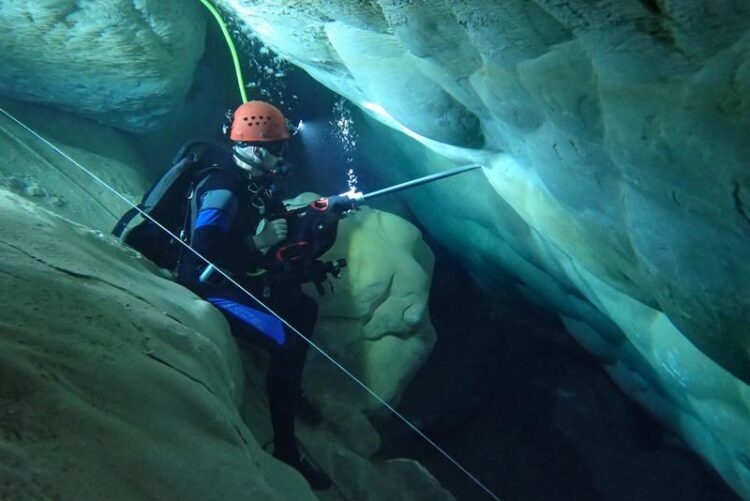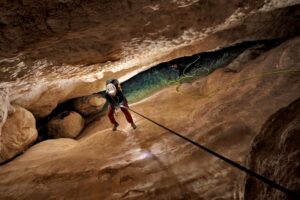Great Basin: History of water supply in one of the driest regions in the USA

A diver takes cores from the cave wall with a drill. Using an underwater drill specially developed for the expedition to Devils Hole, the researchers took samples from the calcite deposits in the cave.
(c) Robbie Shone
An international team including Simon Steidle from the Quaternary Research Group at the Department of Geology at the University of Innsbruck has reconstructed the evolution of groundwater in the Great Basin, USA – one of the driest regions on Earth – up to 350,000 years into the past with unprecedented accuracy. The results shed new light on the effects of climate change on water supply and provide important insights for the sustainable use of groundwater resources. The study was published in the journal Nature Communications Earth & Environment.

(c) Robbie Shone
The team led by Christoph Spötl has been investigating the famous “Devils Hole” cave system in Nevada since 2010 – during spectacular expeditions (https://www.uibk.ac.at/en/newsroom/2017/devilshole/). Using the calcite deposits in the cave, the researchers have already reconstructed the development of the water level in the cave up to several hundred thousand years ago. In the current study, this information has now been combined with a numerical groundwater model for this arid region. “Based on our extensive sampling in Devils Hole, we have a large amount of data that provides information on the evolution of the water table. By combining this with groundwater models from the US Geological Survey, we can now draw quantitative conclusions about changes in precipitation for the entire region over the last 350,000 years using the precise data from the cave,” explains the geologist Simon Steidle. In drylands like the southwest of the USA, precipitation is particularly important and groundwater data is a mirror of changes in the hydroclimate. “The results can be useful for developing water management strategies and sustainable use of groundwater resources, such as how much water can be withdrawn for agricultural purposes.”
Drought increases sensitivity
The new data suggest that the elevation of the water table in Devils Hole was three to four times more sensitive to groundwater recharge during dry climates than during wetter climates of the past. “Given that drought conditions will likely increase even more in the future due to the ongoing climate crisis, our results highlight the vulnerability of large aquifers, and thus the alteration of the most important freshwater resource in this area of the United States,” Steidle said.
The minimum groundwater level in Devils Hole during the peak of the interglacial warm periods was no more than 1.6 metres below today’s level, which corresponds to a decrease in groundwater recharge of less than 17 % compared to today’s conditions. During the glacial periods, however, the level was at least 9.5 metres above today’s level, which means an increase in groundwater recharge of almost 250% compared to today’s conditions.
The new information is relevant especially for the already highly endangered Devils Hole pupfish, a fish measuring just a few centimetres whose only habitat is the water in Devils Hole. The habitat of this species is thus the smallest of all known vertebrates (about half the size of an average classroom). Even small changes in water availability triggered by abstraction of groundwater for irrigation purposes or by climate change are of utmost importance for its survival.
Publication:
A 350,000-year history of groundwater recharge in the southern Great Basin, USA: Tracie R. Jackson, Simon D. Steidle, Kathleen A. Wendt, Yuri Dublyansky, R. Lawrence Edwards & Christoph Spötl. Communications Earth & Environment, 4:98 (2023), https://doi.org/10.1038/s43247-023-00762-0
Wissenschaftliche Ansprechpartner:
Univ.-Prof. Dr. Christoph Spötl
Institut für Geologie
Universität Innsbruck
E-Mail: Christoph.Spoetl@uibk.ac.at
Web: https://quaternary.uibk.ac.at/
Originalpublikation:
A 350,000-year history of groundwater recharge in the southern Great Basin, USA: Tracie R. Jackson, Simon D. Steidle, Kathleen A. Wendt, Yuri Dublyansky, R. Lawrence Edwards & Christoph Spötl. Communications Earth & Environment, 4:98 (2023), https://doi.org/10.1038/s43247-023-00762-0
Media Contact
All latest news from the category: Earth Sciences
Earth Sciences (also referred to as Geosciences), which deals with basic issues surrounding our planet, plays a vital role in the area of energy and raw materials supply.
Earth Sciences comprises subjects such as geology, geography, geological informatics, paleontology, mineralogy, petrography, crystallography, geophysics, geodesy, glaciology, cartography, photogrammetry, meteorology and seismology, early-warning systems, earthquake research and polar research.
Newest articles
Faster, more energy-efficient way to manufacture an industrially important chemical
Zirconium combined with silicon nitride enhances the conversion of propane — present in natural gas — needed to create in-demand plastic, polypropylene. Polypropylene is a common type of plastic found…

Energy planning in Ghana as a role model for the world
Improving the resilience of energy systems in the Global South. What criteria should we use to better plan for resilient energy systems? How do socio-economic, technical and climate change related…

Artificial blood vessels could improve heart bypass outcomes
Artificial blood vessels could improve heart bypass outcomes. 3D-printed blood vessels, which closely mimic the properties of human veins, could transform the treatment of cardiovascular diseases. Strong, flexible, gel-like tubes…





















